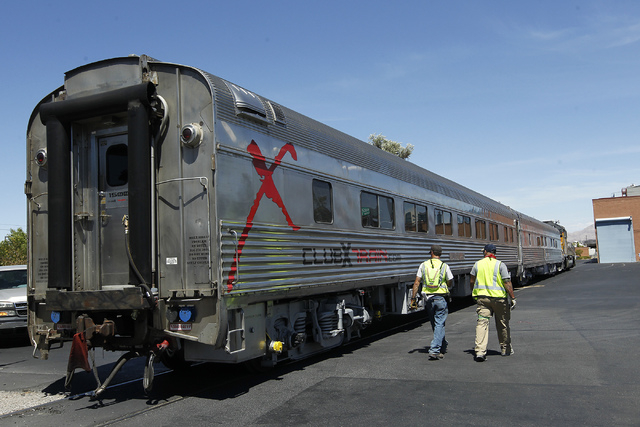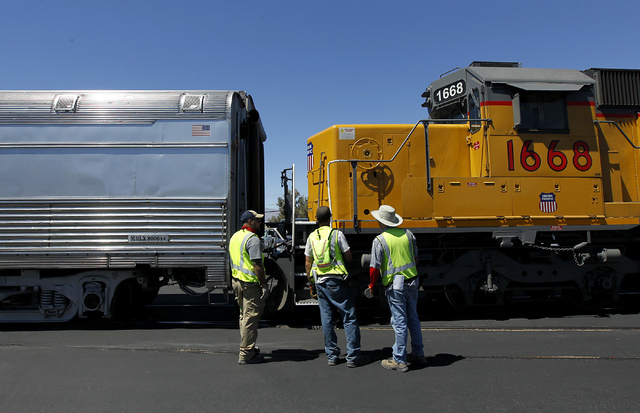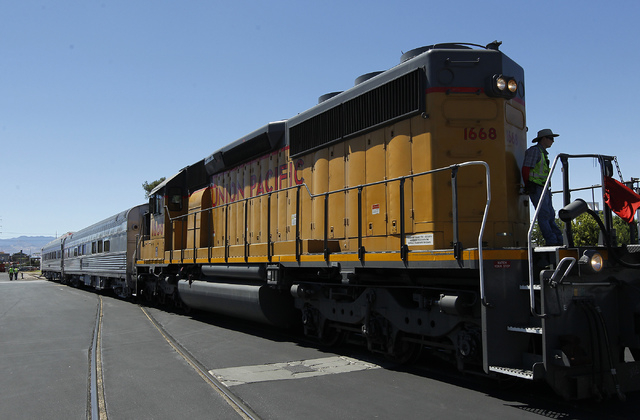Las Vegas rail service plans have seen starts, stops
It’s been 6,320 days since Las Vegas has seen regularly scheduled passenger train service.
Amtrak trains once stopped at a platform at downtown’s Union Plaza, today known as the Plaza, when the Desert Wind made its round trips from Los Angeles’ Union Station to Salt Lake City.
When Amtrak discontinued the route on May 12, 1997, tourism leaders were confident that it wouldn’t be long before some form of rail service was restored.
It never happened. But not for lack of trying.
At the time, momentum was growing to adapt the new magnetic levitation technology and a two-state commission was formed to get maglev on track. Others contemplated traditional rail systems along the same route Amtrak had used. And some looked to high-speed rail as a solution.
Even Amtrak weighed in with a proposal to use Spanish-built conventional rail trains from Los Angeles to Las Vegas, just as the company had with a successful project in the Pacific Northwest.
But as funding dwindled for Amtrak, the L.A.-Las Vegas proposal was dropped.
When Barack Obama was elected president, rail aficionados were encouraged because he made high-speed rail one of his transportation priorities. Obama wanted to see the fastest train in the world and he wanted to see it in the U.S. Maglev backers thought Obama was talking about them.
But maglev believers were delivered a setback in 2009 when Sen. Harry Reid, a longtime supporter, grew frustrated with the lack of progress and threw his support and funding opportunities behind a high-speed rail project, then called Desert Xpress. Some viewed the move as political given that casino industry interests were behind the 185-mile line and its 150 mph trains that initially would have taken passengers between Victorville, Calif., and Las Vegas.
Desert Xpress eventually rebranded itself as XpressWest, taking on a mission of making its L.A.-Las Vegas train the first piece of a Western network of high-speed rail.
The X Train, pitched by a public company called Las Vegas Railway Express, emerged as a conventional rail option, even though most transportation leaders dismissed it as a six-hour amusement park ride because it billed itself as a “party train.”
XpressWest and the X Train pressed on in the ensuing years. XpressWest, cutting a new route through the desert, focused on winning environmental approvals through a maze of government agencies. The X Train negotiated rail car purchases and battled to negotiate track use with Union Pacific, which has prioritized the movement of freight to Southern Nevada and Utah on its rails and not passenger excursions.
Both companies promised passenger rail service in the future.
XPRESSWEST DERAILED
Then, in 2013, the wheels came off for XpressWest. Needing a $5.5 billion loan from the federal Railroad Rehabilitation and Improvement Financing Program overseen by the Federal Railroad Administration for the project to proceed, XpressWest was notified by the U.S. Transportation Department that it was suspending its loan review for the XpressWest project.
The X Train, meanwhile, was having its own problems. The company was told that it wouldn’t be allowed to drop passengers off at the Plaza platform. Company officers then vowed to build a platform in North Las Vegas instead, a strategy critics mocked. The final blow was that the company couldn’t secure an agreement to use Union Pacific’s tracks on a route that would have taken passengers from Fullerton, Calif., east through Daggett, Calif., then north through the Mojave National Preserve to Las Vegas. The company reportedly lost millions in cancellation fees with Union Pacific.
The company then promised but failed to deliver weekly charter excursions on the X Train after showing off the company’s remodeled club car and serving gourmet appetizers to Las Vegas tourism leaders.
Passenger train service for Las Vegas is no further along today than it was the day the Desert Wind blew out of town. What happened?
X TRAIN DEPARTS
For the X Train, the answer is easy. The company whose biggest failing was promising more than it could deliver has taken on a new opportunity that has nothing to do with Las Vegas.
In April, the company signed an agreement with Santa Fe Southern Railway to provide dinner, brunch and “murder mystery” excursions on an 18-mile rail line between Santa Fe and Lamy, N.M.
Movie buffs and “Breaking Bad” fans are familiar with it. New Mexico touts the line as a location for movie shoots involving trains. It’s the same train line that the producers of “Breaking Bad” used in its final season when Walter White and Jesse Pinkman robbed a tanker car filled with a chemical used to make methamphetamine.
Earlier this month, the company moved a rail car that it had refurbished in Las Vegas for its planned Southern California runs to New Mexico.
Penny White, president and chief operations officer of X Train Holdings, said the New Mexico train tour has been wildly popular in the company’s first month of operations.
“It’s fantastic,” White said. “We’ve gotten a lot of press from the Santa Fe and Albuquerque newspapers and food critics have interviewed Chef Tim.”
Chef Tim Welc and Scott Mahan of Masterpiece Cuisine of Las Vegas are the food providers for the three-hour trips that sell for $59 to $159, depending on the experience.
Trains operate Wednesdays through Sundays, twice a day. White said each train holds 90 passengers and the company plans to operate once a day during the winter.
The Santa Fe tour train had been shut down for 18 months until the X Train arrived, but executives of the company met the Las Vegas contingent at a conference and struck the deal to operate on the line.
The startup of the Santa Fe project has put the company’s plans for a party train between Los Angeles and Las Vegas on hold.
“It’s definitely a lower priority for us,” White said. “In fact, we’re looking to start similar excursion lines in other locations, one by the end of the year another by the middle of next year.”
White wouldn’t disclose the locations.
HELP FROM UNLV
As for L.A.-Las Vegas, X Train officials are working with students from UNLV’s College of Engineering to negotiate a new route for Los Angeles to Las Vegas that wouldn’t depend on tracks in the steep Cajon Pass rail corridor. White said the company is investigating options on a traditional rail route that would pass through Palmdale, Mojave and Barstow in California to get to Las Vegas.
Hualiang “Harry” Teng, associate professor of civil environmental engineering and construction at UNLV and a longtime supporter of high-speed rail in Southern Nevada, doesn’t mind that his students would work on a conventional rail tour project and not high-speed rail.
“It’s a good opportunity for our students to be involved in a real project,” Teng said. “They’ll be in a working rail transportation office and get experience like in an internship.”
Teng and his UNLV colleagues had high hopes for the various transportation proposals for Southern Nevada. The department sponsored open forums about maglev and high-speed rail and the program remains committed to being a resource to educate workers when a project gains traction.
While XpressWest seemed like a sure thing two years ago when company executives announced an agreement to work with Los Angeles’ Metrolink to develop a train line between Palmdale and Victorville, Calif., hope faded when the review of the federal loan ended.
Two high-ranking Republican lawmakers, Wisconsin Rep. Paul Ryan, chairman of the House Budget Committee, and Alabama Sen. Jeff Sessions, ranking member of the Senate Budget Committee, wrote a letter to then-Transportation Secretary Ray LaHood informing him of their request for a Government Accountability Office evaluation of XpressWest’s loan application.
‘SIGNIFICANT UNCERTAINTIES’
The two lawmakers cited “significant uncertainties” in XpressWest’s ability to repay the federal loan. Also, LaHood cited the company’s failure to follow “Buy America” provisions that give preference to the use of domestically produced materials on any transportation infrastructure improvements funded at least partly by federal funds.
XpressWest said the company wasn’t subject to Buy America because there are no high-speed train manufacturers based in the United States. The company had longtime relationships with Bombardier, a Canadian transportation equipment manufacturer.
Whether because of political pressure or noncompliance to Buy America, the project seemed dead. XpressWest cleared out of the office it had just up the block from the X Train team near McCarran International Airport.
Although the loan request’s rejection is now more than a year old, there are indications XpressWest may be gearing for another run.
In a recent appearance in Las Vegas, Reid said the loan request may resurface in “a matter of months.”
“(California Gov.) Jerry Brown and I spoke recently about our trains,” Reid said. “We both have a vision of high-speed rail in America. Amtrak is not high-speed rail. It’s an antiquated system, and I’m glad we have it, but it’s not very good.”
Reid noted that construction of California’s high-speed rail system linking San Francisco and Los Angeles is underway. The route passes through Palmdale — the place where XpressWest eventually would link its high-speed train to Los Angeles. Reid said an environmental assessment of the right-of-way between Victorville and Palmdale is complete and leaders are looking at how it could work around Buy America provisions.
‘ASSEMBLING IN AMERICA’
Reid believes there should be no Buy America requirement for the project because there are no American companies that produce the type of train cars and components the company requires for the project. Instead, Reid said materials manufactured outside the United States would be acquired and the trains would be assembled by American workers.
“We’re looking at another way of doing this — assembling in America,” Reid said.
Not only would the project produce manufacturing jobs in assembly plants, but construction workers would be needed along the length of the track.
“Think of it: tens of thousands of construction jobs and that doesn’t even count the work on the California (high-speed rail) project,” Reid said.
XpressWest’s shortcoming had always been the initial phase of the project — construction of the link between Victorville and Las Vegas.
In its ridership studies, XpressWest said most of its prospective customers would come from the California’s Inland Empire and not along the coast, making Victorville a viable end point.
Most of the public never believed that customers would drive 80 miles from Los Angeles to Victorville to ride a train for just over an hour to get to Las Vegas — without a car.
Las Vegas residents were even more critical, vowing they’d never ride the train to Victorville and rent a car there for the last hour of driving into the valley.
It wasn’t until the company was well into the planning of the Las Vegas-Victorville line that it introduced the revised plan to connect west to Palmdale and south to Los Angeles.
‘TRAIN TO NOWHERE’
But by then, the damage had been done. XpressWest and Victorville had become the butt of jokes. The project was no longer referred to as a high-speed link to Los Angeles but a “train to nowhere.”
Even if Reid and the company succeed with their efforts to work around the Buy America provision for the loan, they still would have to convince the Federal Railroad Administration that ridership projections are accurate and solid enough to guarantee the loan would be paid back. Ryan and Sessions would surely be back to press the issue.
If there’s a rebound in the future, it could be one of the biggest business turnarounds in history.
Reid said the effort is being fronted by Anthony Marnell II, who already has invested an estimated $60 million in the XpressWest project.
Efforts by the Las Vegas Review-Journal to interview Marnell were unsuccessful.
Contact reporter Richard N. Velotta at rvelotta@reviewjournal.com or 702-477-3893. Follow @RickVelotta on Twitter.

























